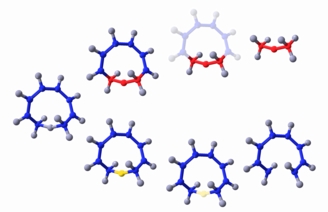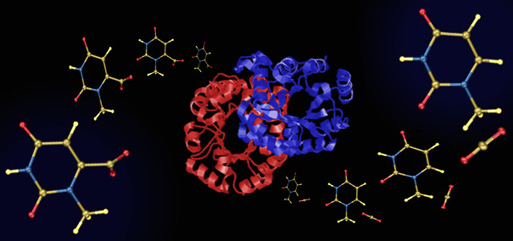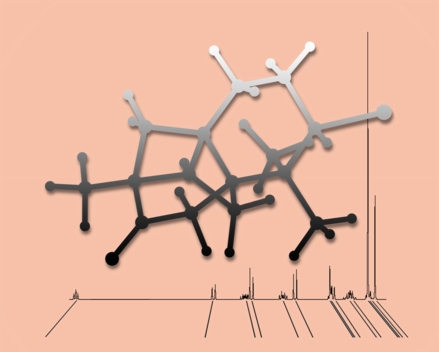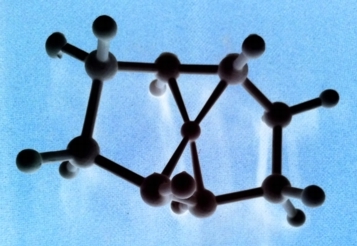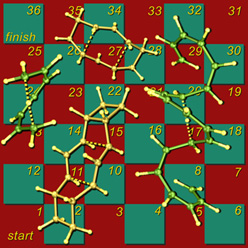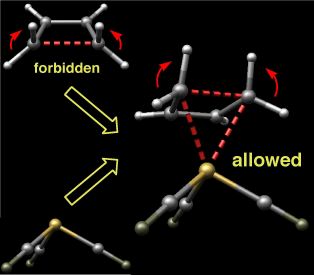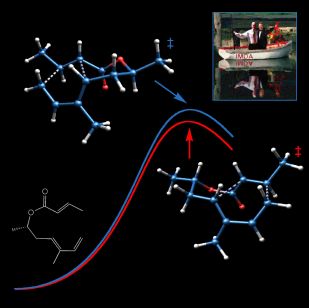![]()
Our research focuses on the application of computational methods to the study of organic reactivity in diverse environments (in the gas phase, in solution, in the interiors of biological macromolecules, as part of organometallic complexes). The intimate relationship between theory and experiment pervades each of these endeavors, and a focus of our work is the design of molecular architectures with unusual reactivity.
"Playfulness is an incentive for the scientist and a motor of progress."
- Rolf Huisgen, The Adventure Playground of Mechanisms and Novel Reactions, 1994.
"Don't ask yourself what the world needs. Ask yourself what makes you come alive and then go do that. Because what the world needs is people who have come alive."
Reaction Design and Theories of Reactivity
Post-Transition State Bifurcations
Concerted Asynchronous Reactions
Reactive Intermediate Promoted Polycyclization (RIPP) Reactions
Theoretical Bioorganic and Bioinorganic Chemistry
Complexity Creation in Bio- and Biomimetic Syntheses of Natural Products
Nonclassical Cations in Biology
Biosynthetic Dipolar Cycloadditions
Computing Chemical Shifts to Aid Natural Product Structure Elucidation
Hydration of Biologically Active Compounds
Drug Design: Conformational Analysis, Docking, and Library Design
Noncovalent Catalysis of Biological Decarboxylations
Antibody Catalyzed Organic Reactions
Biosynthesis and Molecular Pharmacology of Nitric Oxide and Nitroxyl
Predicting Spectra
Chemical Education
Making Computational Chemistry Accessible to the Blind & Visually Impaired
Organic Molecules with Unusual Properties
Physical Organometallic Chemistry
Metal-Promoted Sigmatropic Shifts
Dirhodium Tetracarboxylate-Promoted Reactions
Rates, Regio- and Stereoselectivity of Synthetically Useful Reactions
Radical Cation Diaza-Cope Rearrangements
Oxidopyrilum Zwitterion + Alkene Cycloadditions
Reactivity of Enamines and Iminium Ions Built from Aziridines
Dissecting Dyotropic Rearrangements
Lewis Acid Promoted Tandem Sigmatropic Shifts/Aromatic Substitutions
The Cationic Cascade Route to Longifolene
Rearrangements of Housane Radical Cations
Stereoselectivity of Intramolecular Diels-Alder Reactions
Regio- and Stereoselectivity of alpha-Lactam Ring-Opening Reactions
"If you don't know the past, how can you know the future?"
- Tony Bennett
"...it is through training in pure research that the mind is best prepared to capitalize broadly on chances as they arise... My area, physical organic chemistry, is a highly interdisciplinary pursuit that provides the principles for the design and synthesis of organic molecules with the goal of uncovering the origins of their structure and properties. It is the conceptual basis for the modern arenas of stereoselective, biomimetic, and materials chemistry. It provides basic tools for medicinal, environmental, and biological chemistry. So, why is physical organic chemistry viewed as off-limits to young scientists who have hopes of establishing research funding? What spoiled the passion for such a central theme in chemistry? Could it be that 'visionaries' who 'knew the way' were allowed to project their futures on that of the field without regard for diversity?"
- Jay Siegel, C&EN, March 26, 2001, p.114
"..the compounds just described [(C5H5)2MX2, M = V, Nb, Ta, X = Cl, Br] were the lineal ancestors of today's marvelous so-called single-site catalysts for olefin polymerization. They were discovered, I would like to emphasize, not by people who had written a grant proposal to work on olefin polymerization, but by people who were funded to do fundamental research that had no predictable practical use."
- F. A. Cotton, J. Organomet. Chem. 2001, 637-639, 18-26
"It has always seemed to me that the most attractive applications of theory are to explore the unknown. If you want to find something truly new, your chances are better if you look in new places."
- Paul Schleyer, J. Comp. Chem. 2001, 13, ix-xi
"Every attempt to employ mathematical methods in the study of chemical questions must be considered profoundly irrational and contrary to the spirit of chemistry."
- Auguste Compte, Philosophie Positive 1830
